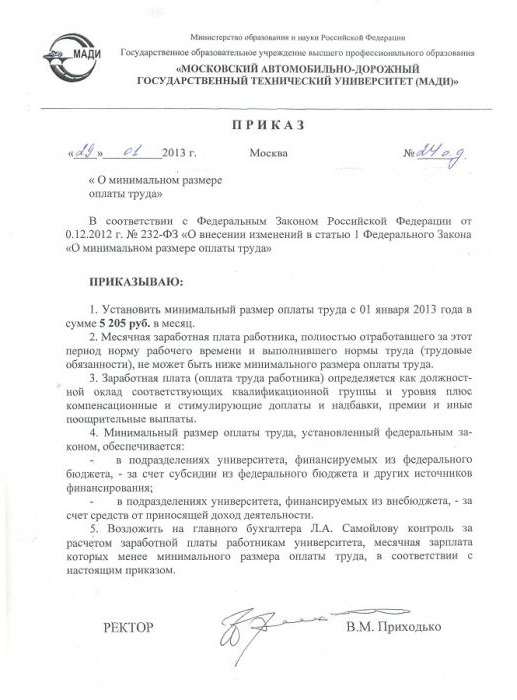Calculation of payment for the work of a part-time worker at the enterprise has a number of significant nuances that distinguish it from the accrual of earnings for ordinary workers. Let's take a closer look at how the legislative norms are applied in practice in the case of the payment of wages to part-time workers, and are they paid up to the minimum wage?
What is the minimum wage?
First of all, let's find out what the minimum wage is. The minimum wage is the minimum legislatively fixed by the state that the employer is required to pay to the employee per month for the fully worked out time standard. Also, this indicator can be used in the calculation of taxes, fines and fees.

In the Russian Federation, the lower level of wages for 2015 is set at 5965 rubles, which is 411 rubles more than in the previous year. The minimum allowable wage is set annually, and its amount is constantly increasing. This is connected, on the one hand, with inflationary processes in the country and indexation of tariffs in this connection, and on the other hand, with the desire of state structures to increase the real standard of living of the population.
In addition, there are regional minimum wages. For each region, they are set separately, but cannot be less than the national level. However, the employer may in writing withdraw from the local minimum wage agreement within thirty days from the date of its official publication. In this case, in case of violation of the minimum regional level of the amount of wages paid, penalties will not be applied to this company.
What should be included in the minimum wage?
But the logical question arises: "In the actual calculation of wages, should the salary or the size of all accrued income be not less than the legislatively established minimum?" Let's find out what types of surcharges are included in the minimum wage.
Unfortunately, in the law on the minimum wage, there is no clear explanation for this. Specific clarifications are available in a special letter of the Ministry of Finance of the Russian Federation published in 2009. According to this letter, the employer has the right to include bonuses, surcharges, allowances and other additional accruals in the minimum salary.
At the same time, the amount of the minimum wage should not include material assistance and other one-time payments that are not directly related to the employee's labor activity.
When do you need surcharges up to the minimum wage?
Thus, it is necessary to state the fact that the legislation allows the approval of salaries for employees in the enterprise below the minimum wage. But in this case, the difference should be compensated by other payments.

As mentioned above, they may be allowances and bonuses. However, even if, taking into account these additional charges, the amount of the total wage will remain below the minimum, then you can draw up an additional article as an additional payment up to the minimum wage.
In any case, if a person has worked out the amount of time established by the norms, he cannot receive an income below the minimum wage. This norm is guaranteed by the state, and its non-fulfillment entails administrative punishment of the responsible persons, which we will discuss below.
Responsibility for the payment of wages below the minimum wage
If the employer paid his employee or employees a salary below the minimum wage, then according to the current legislation of the Russian Federation, in the event of such facts being discovered by the regulatory authorities or complaints of the workers themselves to the appropriate structures, an administrative fine is imposed on the head of the enterprise in the amount of thirty to fifty thousand rubles. It can also be suspended from activity for a period of up to 90 days. In case of violations at the regional level of the minimum wage, the director of the company may be imposed a penalty of three to five thousand rubles.
Administrative responsibility can also be assigned to the chief accountant or another person responsible for calculating and charging salaries to the personnel of the enterprise.
Is it possible to pay a salary below the minimum wage?
But what to do if a person has worked less than the norm? This provision may arise if, for example, he took leave at his own expense or works part-time. In this case, payroll below the minimum monthly wage is allowed. But again, with the proviso that for a unit of time worked, he should receive an amount equal to or greater than the statutory minimum standards.

In addition, it should be noted that the accrued salary with all additional payments and allowances should not be less than the minimum wage, but the actually paid income minus taxes and fees may be less than the minimum wage.
Documents on the basis of which an employee bonus is charged
The company's management is obliged to issue an order for surcharges up to the minimum wage upon the occurrence of the first relevant case, when in fact the salary accrued to a person is less than the minimum allowable. This document can be generated once for the entire enterprise, and not done every time for a specific person.
The next step is the signing of the order by the director. Based on it, the accounting service calculates the surcharge up to the minimum wage. This is the generally accepted norm.
Moreover, it is not necessary to publish a special document justifying additional charges to the level of the minimum wage. For these purposes, you can use the general order on the minimum wage in the enterprise. But a prerequisite is the presence in it of a clause that would oblige the accounting department to charge the appropriate amount to employees who have an income less than the established norm.
A sample order for surcharges up to the minimum wage is given below.

In addition, all calculations on the calculation of the corresponding salary increases for each employee should be detailed in detail and pinned to the order books for the calculated period. If necessary, they are provided to regulatory authorities.
Calculation of surcharges up to the minimum wage
Many accountants in the process of their work raises the question of how to calculate the surcharge to the minimum wage. I must say that for ordinary workers the calculation is done elementarily. For this, the total income accrued to the employee is deducted from the amount of the minimum wage, which includes the actual salary, as well as various allowances and bonuses. The result obtained will be the amount of the surcharge up to the minimum wage.

However, as practice shows, ideal conditions are far from always met, and in order not to get into a mess with adding the amount to the minimum wage, you need to know the labor legislation well and be able to use its norms in the relevant situation.
How to accrue salary up to the minimum wage level for a part-time worker?
Surcharge up to minimum wage when combined is calculated according to the same method as for an employee working at the same full time, but taking into account the coefficient. For a combination, this calculation has the following form.The amount of the minimum wage is multiplied by the coefficient of rates assigned to a particular employee, after which the amount of accrued salary is deducted from the result, taking into account all allowances and bonuses. Thus, we get the amount that the employee should pay. If the result is negative, it means that you do not need to pay anything extra, because the amount of salary is higher than the established minimum.
This technique is valid in cases when the surcharge to the minimum wage is calculated both for external part-time workers and internal. And we will talk about specific nuances a little lower.
Internal alignment
Nowadays, economic efficiency should be at the forefront of every enterprise. The rational and practical use of labor is not the last place on this issue. The easiest way, of course, is to save on payroll simply cutting salaries for specific employees, but you can use other management tools, and many managers use them.

For example, it is quite profitable for the enterprise to use internal part-timers in its work, especially on types of work that do not require full employment. Not every person, for example, agrees to work for half the minimum wage. But if this person already works at your company, getting a pretty decent salary, then he can happily take on several additional functions for a small surcharge, moreover, often without increasing real working time. Not to mention those situations where, for example, a good specialist is sick for a long time or goes on maternity leave. In this case, internal combination is the best way out, since you do not need to attract outsiders to the work, who still need to be found.
This situation suits both the employee and the employer, who also entrusts new functions not to an unknown person from the street, possibly working for another company at the same time, but to a verified employee. The administration of the company, the introduction of this practice at the same time helps to solve the issue of the efficiency of expenditure of the wage fund and the shortage of workers. Therefore, at present, the use of internal combination is gaining more and more popularity in enterprises.
Restrictions on internal alignment
But, unfortunately, it is necessary to take into account the factor that internal combination can not be applied to all employees and not in all cases. For example, according to the current legislation, part-time workers cannot be employees who are involved in work that is harmful to health or physically difficult. It is also not allowed to combine two posts by minors.
In addition, it should be said that it is impossible to combine the positions of members of the government, employees of the prosecutor's office and the Central Bank.
When appointing a position for combination, it is also necessary to take into account his abilities, education and many other factors. For example, a tractor driver is unlikely to be able to work as an accountant, and vice versa, naturally, if he has not undergone additional training. If the manager appoints an incompetent person to a position related to the risk to the life or health of other people, then such a decision may entail criminal liability for the director of the enterprise.
The nuances of surcharges for minimum wages for internal alignment
Some employers believe that if their employee is an internal part-time job and the total amount of his salary exceeds the minimum rate, then no additional charges should be made. This approach is fundamentally wrong, although it is clear that it appeals to the owners of firms. Indeed, in this case, they do not bear the additional costs of compensating for the difference.

But in fact, an additional payment of up to the minimum wage to internal part-time workers should be made for each workplace separately.Even if in total the employee, working at one and a half wages, receives an income exceeding the amount of the minimum wage. In the opposite case, you not only unreasonably reduce real wages to your employees, but also lower the taxes that the company should pay on employee income. So the incorrect calculation of surcharges for minimum wages can threaten both with lawsuits from employees of the company, and fines issued by regulatory authorities.
An example of calculating surcharges up to the minimum wage level for an internal part-time job
Let's look at how, under the conditions of internal combination, the surcharge to the minimum wage of the watchmen is calculated. An example with specific amounts is given below.
Watchman Ivanov, working full time, has a salary of 3,500 rubles. In addition, he receives a surcharge of 20% for night work, the amount of which, therefore, is 700 rubles, as well as a bonus of 10% of the salary (350 rubles). Also at the same enterprise, he was registered part-time as a territory cleaner. His salary for this type of work is 2500 rubles.
Now we make the determination of the surcharge to the minimum wage, put to him as a guard. His total salary in this position consists of the amount of salary, surcharge for night work and bonuses. Thus, we get the amount of salary accrued to him:
3500 + 700 + 350 = 4550 rubles.
The supplement to the minimum wage for the guards will consist of the difference between the minimum wage (5965 rubles) and the amount of accrued income:
5965 - 4550 = 1415 rubles.
Let's move on to the next step. Now we’ll calculate how much the surcharge will be up to the minimum wage as a cleaner of the territory where he works part-time. Immediately multiply the amount of the minimum wage by a factor of 0.5. To find out what the minimum wage is for the level of employment in this case:
5965 * 0.5 = 2982.50 rubles.
Now subtract from the amount received the amount of accrued wages. In this case, it is equal to the salary value. Thus, we have:
2982.50 - 2500 = 482.50 rubles.
As you can see, the surcharge to the minimum wage of this employee as a caretaker will be 1415 rubles, and as a cleaner of the territory - 482.50 rubles, which in the end will give a very good amount - 1897.50 rubles.
If we initially proceeded from the total amount of earnings for all positions of this employee (7050 rubles), then she would immediately exceed the minimum wage (5965 rubles), and the employee would not receive any additional payment. But again, this approach would be wrong.
The overall result
Thus, we see that compliance with the minimum wage is one of the most important tasks of the state. In order not to conflict with him, the employer must also clearly comply with these standards. Not to mention the fact that in enterprises where they try to maintain high standards in the field of remuneration, employees value their place more and show better results.
Since at present, due to economic efficiency, the use of internal combination is gaining increasing popularity at enterprises, it is very important for the administration of business entities to know the legislative aspects of such working methods. In particular, some nuances should be taken into account when calculating the supplement to internal part-time workers up to the minimum wage level. It is important not to run into lawsuits by employees or penalties based on the results of inspections of regulatory bodies in the future.
The main thing to remember is that the additional payment to part-time workers up to the minimum wage is calculated according to the same scheme as ordinary workers, only for each position separately.








